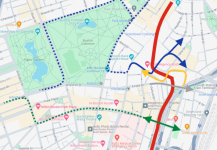Demand for 3-car Type 10s on the GLR, assuming it's feasible?
But I think this ultimately gets at the question of: Is this even a worthwhile goal? Is Medford/Newton/Needham/Seaport traffic really enough to justify platform lengthening across the network? As I mentioned previously 5 minute headways with 2-car Type 10s already quadruples capacity on the Washington St route, for example. Would the extra 50% bump:
- Justify the costs
- Make sense to put towards the GL in the first place? There's plenty of platforms that would need to be lengthened at pretty significant cost. Given that an orbital route would take load off radial routes, would that money be better spent as a nice down payment on a new orbital line?
If we assume feasibility is not a question, I actually feel there will almost certainly be demand for 3-car Type 10s on the core GLR routes: my
Green (North Station-LMA) and
Magenta (Seaport-South Station-LMA) Lines.
(I will use these two colors to exclusively refer to these two trunks.)
First of all, a small but notable distinction: From the
MBTA Green Line study slides (which may be summarizing the paper above), a single Type 10 car
(388 passengers crush load) "only" has equal capacity as two Type 7/8/9s
(Type 7s have 269 crush load per car, Type 8s have 199, both have policy capacity 101, source). Running two-car Type 10s only
doubles your capacity from today, not "quadruples" them.
The point of Green and Magenta are not only to serve Medford, Newton, Needham, etc. They serve some of the most major destinations in both the downtown core and slightly further out: North Station, South Station (Financial District), Back Bay, Seaport, and LMA.
Job numbers, using
US Census OnTheMap: (
Bolded are served by Green and Magenta lines)
- DTX/Financial District/Chinatown (roughly bounded by Tremont St, Stuart/Kneeland St, the waters and State St): 122,453
- Back Bay (between Arlington St and Mass Ave): 69,052
- Seaport: 40,013
- Kendall (roughly bounded by Charles St, Windsor St, Mass Ave and the river): 61,048
- Some offices on the western edge of this region may be closer to Central than Kendall
- LMA (cutoff slightly south of Francis St): 60,615
- Harvard, not counting in Allston (roughly bounded by Ash St, the river, Flagg St, Putman Ave, Ware St, Francis Ave, and Mellen St): 25,270
- Almost entirely from Harvard University itself (so I'd guess it counts the Allston campus too)
GLR really does connect the most major employment centers -
it has bidirectional demand, not limited to residents along the line. Seaport and LMA are the obvious ones, but Back Bay also deserves a big mention. For this reason, I'm actually more concerned about
Magenta than Green.
- The South Station - Back Bay link is too valuable. For anyone from southside Red, Fairmount and Old Colony, Magenta is the easiest way to get to Back Bay. And in an NSRL world, Magenta (SS) may even have an advantage over Green/Orange (NS) for northside riders that are not paired with one of the Back Bay CR lines (there will be a lot of them, because Fairmount). No ring route can help with that (aside from my Mini Ring).
- To LMA, same as above. In fact, a northside OL rider will probably find it more convenient to do an Orange-Green transfer at North Station than anything else. (Especially if the ring route winds through Harvard and Allston.)
- Seaport should be obvious.
- Even for D/E residents going to downtown offices, Magenta at South Station may offer a shorter walk than Green.
And none of these are solely job destinations, either. Back Bay will get its share of Copley, Newbury and Prudential shoppers. So does Seaport with its many shops and restaurants. The hospitals at LMA not only draw employees, but also patients. Downtown Boston, in addition to recreational and tourism activities, will always serve as a transfer hub for anyone who can't be helped by a circumferential line.
I want to reiterate that last point: Regardless of how good your circumferential route(s) are,
there are simply many travel patterns for which radial lines are needed. As
@Riverside described
here, people coming from opposite ends of downtown (including commuter rail) are highly likely to find a downtown transfer the shortest and/or with fewest transfers. Yes, circumferential routes will take some pressure off existing radial subways, but I highly doubt most people will be using them to cross more than 1 or 2 radial lines.
Plus, the target audience of these routes may not even contribute to peak loads on radial lines (including Green and Magenta-equivalents) today in the first place - someone going from RL north to LMA may transfer to the 47 at Central, or just bike/drive. Subway expansions (Green and Magenta included) will also have induced demands. Then there's also the question of
when you expect the Urban Ring to be built, and whether it comes before or after NSRL
(NSRL without a full Urban Ring(s) will obviously dump huge loads on GLR).
Even the residential areas that GLR serves likely deserve high capacity. The D branch today already has high ridership, GLX crosses through Somerville which is one of the densest cities in metro Boston, and the Union Sq branch has long-term potential to be extended all the way to places like Watertown and Waltham.
Today's Green Line already serves as a main spine of the network, even though it wasn't intended to and doesn't have the infrastructure to cope with it. The same will be true for the reconfigured Green and Magenta lines, except they
are intended to be main spines - so let's try to ensure they have the infrastructure for it.
. This could be done as part of the proposed South Station expansion into the USPS location.


